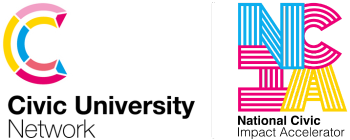When we talk about being a civic university, it can sound a bit abstract. In Lancaster, it's anything but. Civic work is woven into the fabric of what we do, from supporting health partnerships to co-creating projects with local organisations. Our place matters to us, and that's not just a slogan, it's a commitment included in Lancaster University's Strategy.
So, what does civic look like in practice? It looks like long-standing, deep relationships with organisations like Lancaster City Council, Lancaster District Community Volunteer Service, Lancashire and South Cumbria Integrated Care Board, and Lancaster and Morecambe College. These brilliant partners were at the heart of our Community Dialogue Project, and we're so grateful for their time, experience, and absolute passion for listening to local voices.

Participants at a Community Dialogue Project workshop
Building Something Together
This project really started to take shape through the NCIA Action Learning Programme, which gave us the space to move an idea from conversation into action.
For a while, we'd been talking about how to listen better to our communities. Not just ticking boxes, but really hearing what people need and want. The funding meant we could finally move forward, and the result was a Community Dialogue Toolkit, a creative, accessible way to support more meaningful conversations with people who might not usually engage with these kinds of events.
We worked closely with connectors, those people who could bridge the gap between academia and community, and brought together a project team made up of researchers, practitioners, and local voices. The result? A flexible set of tools that anyone can use to spark genuine, thoughtful dialogue.
What We Learned
There were a few big lessons from this project that we'll be carrying forward:
- People's time is valuable. We need to recognise and reward it, because taking part in community dialogue isn't free, especially for those juggling work, family, and life.
- Creativity builds connection. Whether it was drawing, collage, or colourful prompts, we saw over and over again how creative methods opened doors to stories and memories that might have otherwise stayed hidden.
- Relationships are everything. The trust our partners had already built was crucial in reaching groups that hadn't been part of conversations like this before. It reminded us that partnerships aren't just helpful, they're essential.
Why It Matters
Community members already know what's working and what's not, in their places. Our role as a university is to listen, learn, and act in collaboration, not from a distance. Civic engagement isn't about doing for communities, it's about doing with them.

Storyboarding the Community Dialogue Toolkit
What's Next?
Although this phase of the project has wrapped up, we're far from done. The toolkit is out there now, and we're really keen to hear from anyone who's used it or adapted it. If that's you then please tell us what happened!
We're also feeding the insights from the project back to policymakers so they can help shape services and support that truly reflect community voices.
And perhaps most excitingly, we're exploring a new idea that emerged in the early stages of the project: asset-based community mapping. This would place communities at the centre, helping identify what's already available to them and what's missing. It's about seeing strength and potential, not just need.
So yes, the Community Dialogue Project may be technically finished, but in reality, we're only just getting started.
When we talk about being a civic university, it can sound a bit abstract. In Lancaster, it's anything but. Civic work is woven into the fabric of what we do, from supporting health partnerships to co-creating projects with local organisations. Our place matters to us, and that's not just a slogan, it's a commitment included in Lancaster University's Strategy.
So, what does civic look like in practice? It looks like long-standing, deep relationships with organisations like Lancaster City Council, Lancaster District Community Volunteer Service, Lancashire and South Cumbria Integrated Care Board, and Lancaster and Morecambe College. These brilliant partners were at the heart of our Community Dialogue Project, and we're so grateful for their time, experience, and absolute passion for listening to local voices.

Participants at a Community Dialogue Project workshop
Building Something Together
This project really started to take shape through the NCIA Action Learning Programme, which gave us the space to move an idea from conversation into action.
For a while, we'd been talking about how to listen better to our communities. Not just ticking boxes, but really hearing what people need and want. The funding meant we could finally move forward, and the result was a Community Dialogue Toolkit, a creative, accessible way to support more meaningful conversations with people who might not usually engage with these kinds of events.
We worked closely with connectors, those people who could bridge the gap between academia and community, and brought together a project team made up of researchers, practitioners, and local voices. The result? A flexible set of tools that anyone can use to spark genuine, thoughtful dialogue.
What We Learned
There were a few big lessons from this project that we'll be carrying forward:
- People's time is valuable. We need to recognise and reward it, because taking part in community dialogue isn't free, especially for those juggling work, family, and life.
- Creativity builds connection. Whether it was drawing, collage, or colourful prompts, we saw over and over again how creative methods opened doors to stories and memories that might have otherwise stayed hidden.
- Relationships are everything. The trust our partners had already built was crucial in reaching groups that hadn't been part of conversations like this before. It reminded us that partnerships aren't just helpful, they're essential.
Why It Matters
Community members already know what's working and what's not, in their places. Our role as a university is to listen, learn, and act in collaboration, not from a distance. Civic engagement isn't about doing for communities, it's about doing with them.

Storyboarding the Community Dialogue Toolkit
What's Next?
Although this phase of the project has wrapped up, we're far from done. The toolkit is out there now, and we're really keen to hear from anyone who's used it or adapted it. If that's you then please tell us what happened!
We're also feeding the insights from the project back to policymakers so they can help shape services and support that truly reflect community voices.
And perhaps most excitingly, we're exploring a new idea that emerged in the early stages of the project: asset-based community mapping. This would place communities at the centre, helping identify what's already available to them and what's missing. It's about seeing strength and potential, not just need.
So yes, the Community Dialogue Project may be technically finished, but in reality, we're only just getting started.







